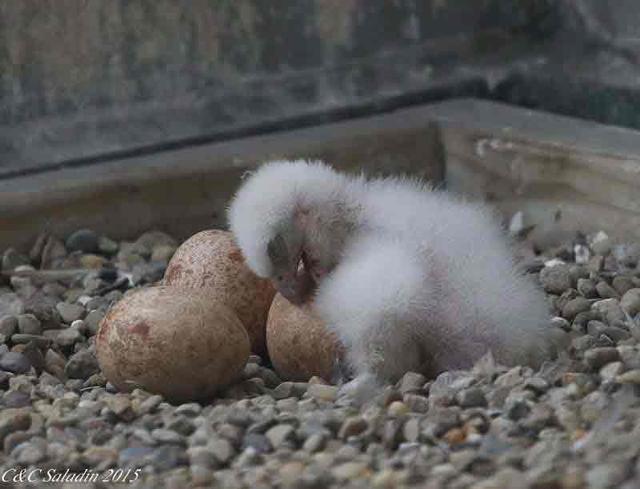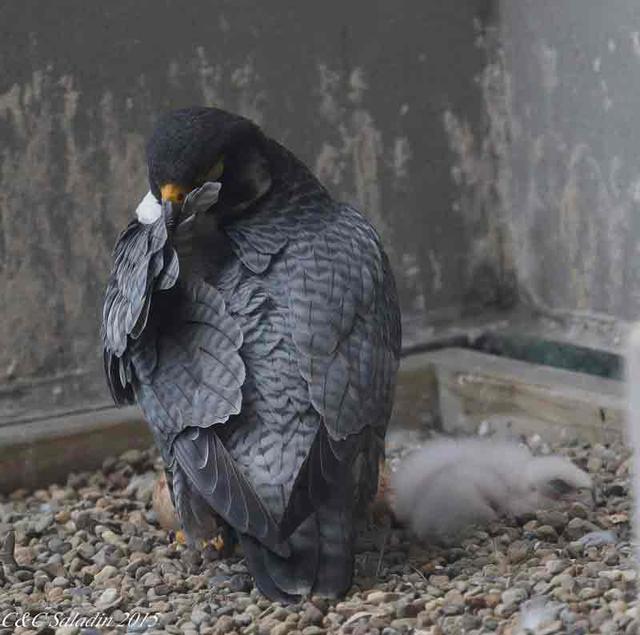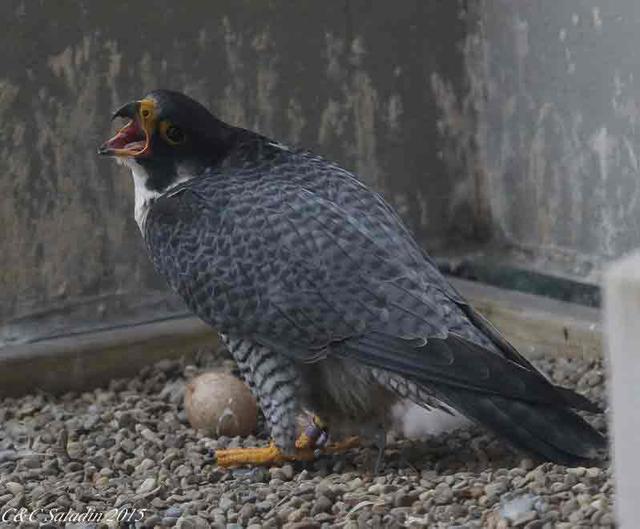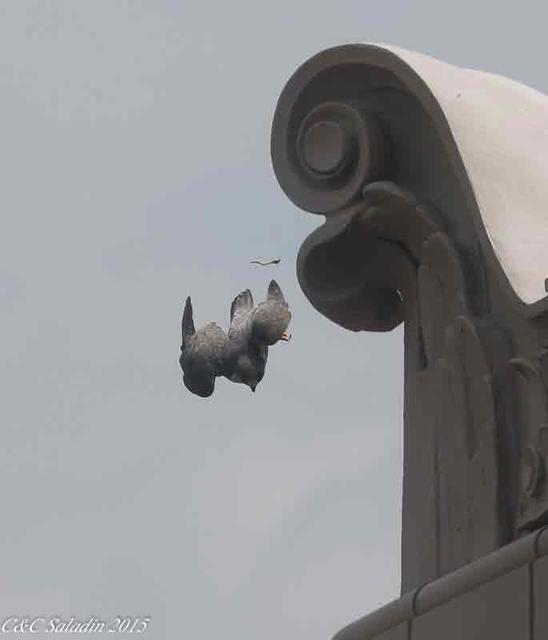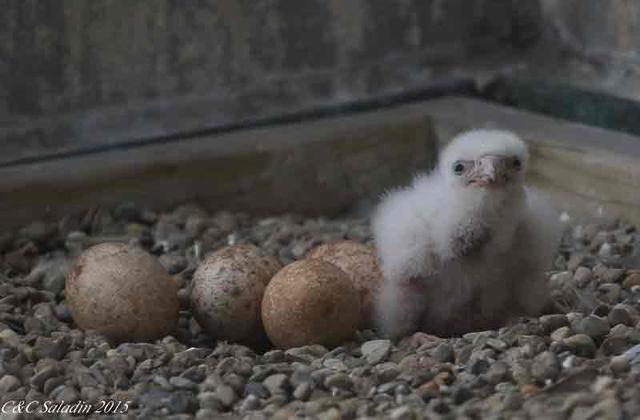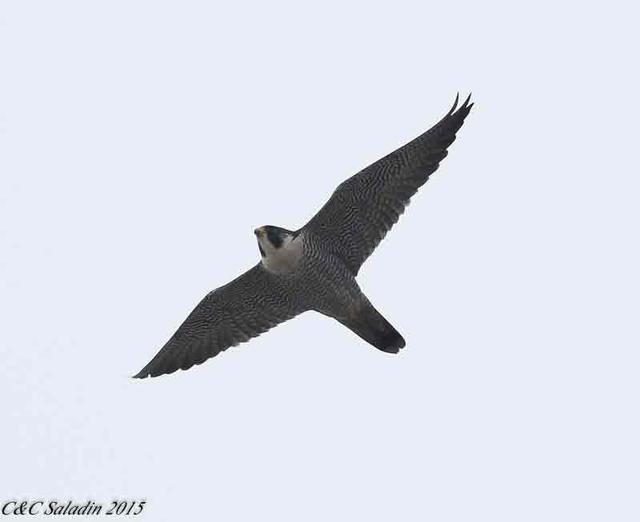FALCON FLASH
Dateline: Cleveland, Ohio
May 21, 2015
Click here to read what happened earlier
Newton was nearby and sped to the nest to protect the eyas as Boomer went out to warn away the intruder.
The eyas is growing very fast and will be banded by the Ohio Division of Wildlife on Tuesday June 2nd - and it needs a name. Put on your thinking caps and send in your suggestions for the name. Here he or
she is at 5 days old. You will see that the little eyas uses its wing nubs to prop itself against the unhatched eggs …….
Here is a clip showing Newton responding to her squirming eyas after she returned from a brief time away and moved in to keep the chick comfortable: https://www.youtube.com/watch?v=9CiGUpkBHmE
An interesting and very important bird activity is “preening” in which a bird cleans its feathers to keep the feathers healthy. Former volunteer nest monitor at this site, Mr. Scott Wright, tells us, “Feathers are a bird's pride and joy and often they will do feather maintenance before they eat or drink”. In the following picture you can see that the tiny eyas instinctively knows to preen its feathers.
While Mrs. S watched, Newton took a break and Boomer came in to take care of their eyas. However, before long he began to make a special call. Mrs. Saladin has learned a bit about peregrine “language” and tells us, “Boomer began "alarm calling" with the sharp "e-chip" that signifies another peregrine was
around. As we've mentioned, this call, rather than the "kekking" is used when the threat is another peregrine...”
When you are thinking of names, keep in mind that this little fluffy eyas will soon grow to be a fierce predator, the fastest creature on earth. Five weeks from now, it will be as big as its parents, fierce and strong. Also, keep in mind that we will not know its sex until after it is examined on banding day. Send your ideas for names by May 28th to raptors@hvc.rr.com
As a newly hatched chick, it is hard for the little eyas even to lift its head up, but this little one is already growing fast and is getting stronger. In fact, it is already trying to move around a bit as you can see in this video http://youtu.be/yy7S8e8aZSs
Mrs. Saladin reports that when it is cooler, “Newton will have to remain with the lone chick, as it only has one coat of down at this point. Brooding usually becomes less necessary after the chick is about 10 days old and the second coat of down develops”.
Send your ideas for names by May 28 to raptors@hvc.rr.com
Watch the falcons live at: http://www.falconcam-cmnh.org/news.php
Our thanks to the Cleveland Museum of Natural History for sponsoring the FalconCams.
The pictures and wonderful commentary are courtesy of volunteer peregrine nest monitors, Mr. and Mrs. Saladin.
Here’s dad showing how a falcon preens:
Newton and Boomer are wonderful parents. Their eyas is safe and warm and very well fed. If you look under its beak, you can see a bump called a “crop”. Mr. Harvey Webster, Director of Wildlife Resources at the Cleveland Museum of Natural History, tells us: “A useful feature found in many species of birds (for when your eyes are bigger than your stomach) is a crop – a thin walled sac off the esophagus. Even after the stomach is filled during a meal, the bird can continue to eat. The extra food is stored in the crop. Then as the food in the stomach is digested, the food in the crop is moved to the stomach. This is particularly apparent in the downy young Peregrines. After a feeding by the parents the crops of the chicks will bulge outward just above their chests….”
We now know that none of the remaining four eggs will hatch and Newton has stopped incubating them. Mrs. Saladin reports, “There were a few flies "bugging" both adults and landing on one of the eggs and even on Newton. I thought at one point she might try to remove an egg as she put her foot lightly on one of them, but she lifted it up and settled in with the chick again. Peregrines will remove bad eggs to keep the nest cleaner and to avoid drawing scavengers”.
Newton and Boomer’s eyas will have the honor of being banded by the Ohio Division of Wildlife, and it may be the only eyas banded this year in the state of Ohio. Next year, the state will probably stop banding peregrine falcon chicks because the species has recovered from near extinction and prospered over the past few decades. Let’s think hard and come up with a very special name for this special peregrine falcon eyas. To remind you of what the little one will look like as an adult, here is a picture of Boomer as he rules over city skies:
Click here to read what happened next



